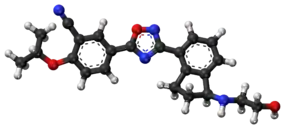Ozanimod
Ozanimod, sold under the brand name Zeposia, is an immunomodulatory drug for the treatment of relapsing multiple sclerosis (RMS), to include clinically isolated syndrome, relapsing-remitting disease, and active secondary progressive disease, in adults.[4][2][5][6] It acts as a sphingosine-1-phosphate (S1P) receptor agonist, sequestering lymphocytes to peripheral lymphoid organs and away from their sites of chronic inflammation.[6] Ozanimod was discovered by The Scripps Research Institute in San Diego, by the labs of Hugh Rosen and Edward Roberts, and licensed to the biotech company Receptos Inc. [7] Receptos was acquired by Celgene for $7.2 billion.[8]
 | |
 | |
| Clinical data | |
|---|---|
| Trade names | Zeposia |
| Other names | RPC-1063 |
| AHFS/Drugs.com | Monograph |
| MedlinePlus | a620029 |
| License data | |
| Pregnancy category |
|
| Routes of administration | By mouth |
| ATC code | |
| Legal status | |
| Legal status | |
| Pharmacokinetic data | |
| Elimination half-life | 19 hours |
| Identifiers | |
| |
| CAS Number | |
| PubChem CID | |
| DrugBank | |
| ChemSpider | |
| UNII | |
| KEGG | |
| ECHA InfoCard | 100.247.081 |
| Chemical and physical data | |
| Formula | C23H24N4O3 |
| Molar mass | 404.470 g·mol−1 |
| 3D model (JSmol) | |
| |
| |
The most common adverse reactions are upper respiratory infection, hepatic transaminase elevation, orthostatic hypotension, urinary tract infection, back pain, and hypertension.[5]
Ozanimod was approved for medical use in the United States in March 2020,[9][4][5] in the European Union in May 2020,[3] and in Australia in July 2020.[1]
Pharmacology
Pharmacodynamics
Ozanimod is an agonist of the S1P1 and S1P5 receptors.[6] It demonstrates this effect in a dose-dependent manner, with 10-fold potency to three comparators.[6] This is an improvement of selectivity over its predecessor, fingolimod, which is non-specific to all 5 isotypes.[6] The agonism of S1P directly causes its internalization and degradation through the ubiquitin-proteosome pathway.[10] The loss of S1P leads to a decrease in the total lymphocyte count in circulation, specifically CD4+ CCR7+ and CD8+ CCR7+ T cells.[6][11]
Pharmacokinetics
Ozanimod has a high oral bioavailability, a circulating half-life of about 19 hours, and reaches highest blood plasma concentrations after about 6 hours.[6][11] Ozanimod is dehydrogenated by two CYP enzymes into two active metabolites, all with similar pharmacokinetics.[11] The decrease in lymphocyte count lasts for approximately 14 days after treatment discontinuation.[11] Unlike fingolimod, it does not require phosphorylation for activation, nor does it demonstrate cardiac abnormalities or hepatotoxicity.[6]
Clinical trials
Touchstone
Touchstone is a double-blind, placebo controlled phase II clinical for the treatment of ulcerative colitis.Clinical trial number NCT01647516 at ClinicalTrials.gov.[12][13] 197 patients, ages 18–75, with moderate to severe UC (Mayo Score 6-10) were recruited and assigned either placebo, 0.5 mg or 1 mg of oral ozanimod followed by 1 week of dose escalation. The 1 mg dose showed a slight increase in rate of clinical remission of UC and total lymphocyte decrease as compared to the placebo, with the most common adverse effects being headaches and anemia.[12] The authors noted that limitations on this study included a brief duration and small sample size, meaning they could not assess safety nor efficacy.[12]
Radiance
Radiance is a double-blind, placebo controlled phase combined II/III clinical trial for the treatment of relapsing multiple sclerosis.[14][15] For the phase II trial, 258 patients, ages 18–55 with RMS (Mean Expanded Disability Status Scale of 2.9) were assigned either placebo, 0.5 mg or 1 mg of oral ozanimod followed by 1 week of dose escalation.[14] Ozanimod significantly reduced MRI lesion activity in participants with relapsing multiple sclerosis over a period of 24 weeks.[14] Both doses of ozanimod reached anticipated range of 60-70% decreased lymphocyte count, and were well tolerated, with a safety profile consistent with a previous phase 1 study in healthy volunteers.[14][16] The most common adverse effects as compared to the placebo were: nasopharyngitis, headache, and urinary-tract infections, with no serious infectious or cardiac adverse effects.[14] With these results, both doses of ozanimod were taken forward into the 2-year long phase III trial and is completed but unpublished as of November 2016.[14][15]
Commercial
After going public in May 2013, Receptos, Inc. stock surged with the clinical data ozanimod displayed as a S1P immunomodulating drug.[18][19] In August 2015, Receptos was acquired by Celgene for $7.2 billion through a combination of cash in hand and new debt, leading to a 22% increase in their stock value.[8][20] Receptos, Inc. (Celgene) patented the synthesis of ozanimod in July 2016.[21] With the expansion of Celgene's inflammation and immunology profile, the company had been expecting to generate $4 to $6 billion in annual sales from ozanimod; however, the FDA rejected its application for the drug's approval in February 2018.[19][22][23] Celgene refiled in March 2019. As the new owner, Bristol-Myers Squibb received FDA approval on March 26, 2020, for ozanimod (Zeposia) oral capsules to treat adults with relapsing forms of multiple sclerosis (MS), including relapsing-remitting MS (RRMS), active secondary progressive MS (SPMS), and clinically isolated syndrome (CIS).[5] Ozanimod was approved for medical use in the European Union in May 2020,[3] and in Australia in July 2020.[1]
History
The US Food and Drug Administration (FDA) approved ozanimod based on evidence from two clinical trials (Trial 1/NCT 02294058 and Trial 2/ NCT02047734) of 1767 subjects with relapsing forms of multiple sclerosis.[4] The trials were conducted at 173 centers in the United States, Belarus, Poland, Russia and Ukraine.[4] Subjects received ozanimod or comparator (interferon β1a, a product approved for the treatment of relapsing forms of multiple sclerosis) for up to one year (in Trial 1) or up to two years (in Trial 2).[4] Neither the subjects nor the health care providers knew which treatment was being given until the trials were completed.[4] The benefit of ozanimod was evaluated based on the percentage of subjects who experienced reduction in disease relapse in comparison to subjects treated with interferon β1a.[4]
Research
Ozanimod is in development for additional immune-inflammatory indications, including ulcerative colitis and Crohn's disease.[5][6]
References
- "Zeposia Australian Prescription Medicine Decision Summary". Therapeutic Goods Administration (TGA). 27 July 2020. Retrieved 16 August 2020.
- "Zeposia (ozanimod) capsules, for oral use" (PDF). Celgene Corporation. 25 March 2020. Retrieved 26 March 2020.
- "Zeposia EPAR". European Medicines Agency. 26 March 2020. Retrieved 17 August 2020.
- "Drug Trials Snapshots: Zeposia". U.S. Food and Drug Administration (FDA). 25 March 2020. Retrieved 1 April 2020.
 This article incorporates text from this source, which is in the public domain.
This article incorporates text from this source, which is in the public domain. - "U.S. Food and Drug Administration Approves Bristol Myers Squibb's Zeposia (ozanimod), a New Oral Treatment for Relapsing Forms of Multiple Sclerosis". Bristol-Myers Squibb Company (Press release). 26 March 2020. Retrieved 26 March 2020.
- Scott FL, Clemons B, Brooks J, Brahmachary E, Powell R, Dedman H, et al. (June 2016). "Ozanimod (RPC1063) is a potent sphingosine-1-phosphate receptor-1 (S1P1 ) and receptor-5 (S1P5 ) agonist with autoimmune disease-modifying activity". British Journal of Pharmacology. 173 (11): 1778–92. doi:10.1111/bph.13476. PMC 4867749. PMID 26990079.
- "FDA approves ozanimod, a drug invented at Scripps Research, for treatment of multiple sclerosis". www.scripps.edu. Retrieved 2020-12-05.
- "Celgene to Acquire Receptos, Advancing Leadership in Immune-Inflammatory Diseases". Celgene Corporation (Press release). 14 July 2015. Archived from the original on 17 July 2015. Retrieved 26 March 2020.
- "Drug Approval Package: Zeposia". U.S. Food and Drug Administration (FDA). 23 April 2020. Retrieved 3 October 2020.
- Jo E, Sanna MG, Gonzalez-Cabrera PJ, Thangada S, Tigyi G, Osborne DA, et al. (June 2005). "S1P1-selective in vivo-active agonists from high-throughput screening: off-the-shelf chemical probes of receptor interactions, signaling, and fate". Chemistry & Biology. 12 (6): 703–15. doi:10.1016/j.chembiol.2005.04.019. PMID 15975516.
- Juif PE, Kraehenbuehl S, Dingemanse J (August 2016). "Clinical pharmacology, efficacy, and safety aspects of sphingosine-1-phosphate receptor modulators". Expert Opinion on Drug Metabolism & Toxicology. 12 (8): 879–95. doi:10.1080/17425255.2016.1196188. PMID 27249325. S2CID 21915268.
- Sandborn WJ, Feagan BG, Wolf DC, D'Haens G, Vermeire S, Hanauer SB, et al. (May 2016). "Ozanimod Induction and Maintenance Treatment for Ulcerative Colitis". The New England Journal of Medicine. 374 (18): 1754–62. doi:10.1056/NEJMoa1513248. PMID 27144850.
- Clinical trial number NCT01647516 for "Efficacy and Safety Study of RPC1063 in Ulcerative Colitis" at ClinicalTrials.gov
- Cohen JA, Arnold DL, Comi G, Bar-Or A, Gujrathi S, Hartung JP, et al. (April 2016). "Safety and efficacy of the selective sphingosine 1-phosphate receptor modulator ozanimod in relapsing multiple sclerosis (RADIANCE): a randomised, placebo-controlled, phase 2 trial". The Lancet. Neurology. 15 (4): 373–81. doi:10.1016/s1474-4422(16)00018-1. PMID 26879276. S2CID 3236201.
- Clinical trial number NCT01628393 for "Efficacy and Safety Study of RPC1063 in Relapsing Multiple Sclerosis Patients (Radiance Study)" at ClinicalTrials.gov
- Hartung J (2012). "Results of a Thorough QT/QTc (TQT) Study of Orally Administered RPC1063, a Novel, Selective S1P1 Receptor Agonist, in Healthy Adult Volunteers" (PDF).
- Clinical trial number NCT02294058 for "Phase 3 Study of RPC1063 in Relapsing MS" at ClinicalTrials.gov
- Pollack A (2015-07-14). "Celgene Agrees to $7.2 Billion Deal for Receptos". New York Times.
- "Celgene 2015 Annual Report" (PDF).
- "Celgene to Buy Receptos for $7.2 Billion". Wall Street Journal. July 14, 2015.
- US 9388147, Yeager AR, Brahmachary E, Martinborough E, Scott FL, Timony GA, Brooks JL, Tamiya J, Huang L, Moorjani M, Boehm MF, Hanson MA, Peach R, "Selective sphingosine 1 phosphate receptor modulators and methods of chiral synthesis", published 22 October 2015, assigned to Receptos and Celgene International II Sarl
- "Celgene to Acquire Receptos for $7.2B". Genetic Engineering & Biotechnology News. 2015-07-14.
- Editorial, Reuters. "U.S. FDA rejects filing for Celgene MS drug, shares fall". U.S. Retrieved 2018-03-28.
External links
- "Ozanimod". Drug Information Portal. U.S. National Library of Medicine.
- "Ozanimod hydrochloride". Drug Information Portal. U.S. National Library of Medicine.